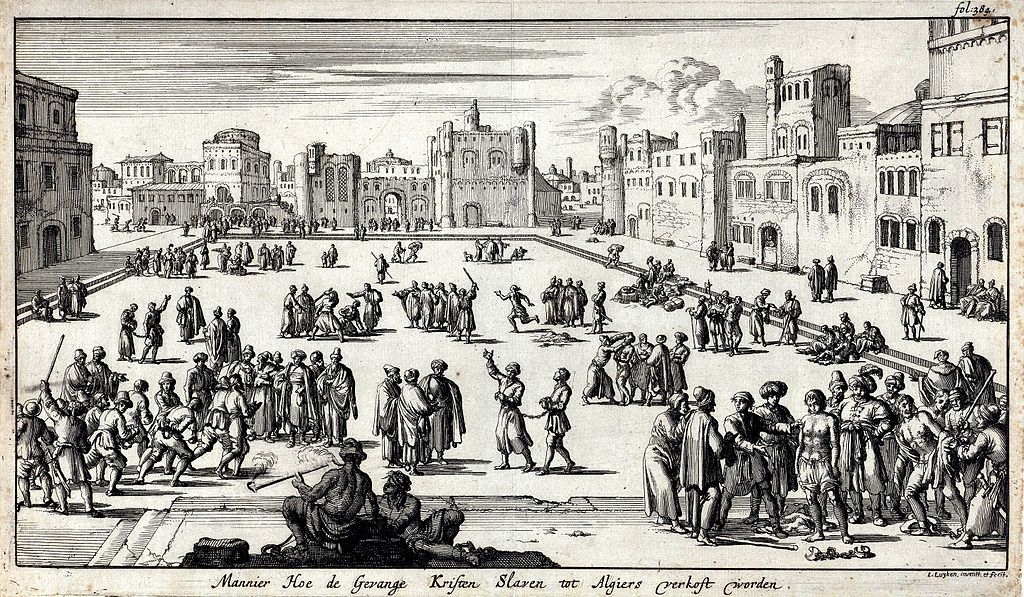 The
origins of slavery are white. Slavery is an integral part of human
history, and the practice of slavery is not the prerogative of any
particular group. The Republic of Venice (697-1797 AD) made a specialty
of transporting shiploads of white slaves from Northern and Eastern
Europe to Constantinople and from the Black Sea to North Africa.
Pictured: "The way in which Christian prisoners are sold as slaves at
the Algiers market," an engraving from 1684 by Jan Luyken. (Image
source: Amsterdam Historic Museum/Wikimedia Commons) |
In August 2019, The New York Times initiated The 1619 Project,
consisting of a collection of articles designed to illustrate that
slavery was "one primary reason the colonists fought the American
Revolution". This project is directed by Nikole Hannah-Jones, a New York Times staff reporter who is not a historian but an avowed "critical race theory" activist. [2]
When American historians denounced
the obvious falsehood of this assertion, and its revisionist and
negationist nature against proven, documented and source-based
historical reality, The New York Times altered the original version of the articles in question to say "some" colonists fought to defend the practice of slavery. The New York Times stated:
"We recognise that our original language could be read to
suggest that protecting slavery was a primary motivation for all of the
colonists. The passage has been changed to make clear that this was a
primary motivation for some of the colonists."[3]
This modest "clarification", so superficial that The New York Times only bothered to make it after a large mobilisation
of historians, destroys the essence of the 1619 Project, which is to
show that slavery is supposedly the foundation of American society and
the ideal in which American revolutionaries were macerating. Moreover,
to say that "some colonists" thought this way is completely meaningless,
in the same way that "some colonists" had brown eyes or had nightmares.[4] It should be noted that many colonists, including Quakers[5], vehemently opposed slavery and worked tirelessly on both sides of the Atlantic until they finally achieved its abolition.
The 1619 Project literature is characteristic of today's neo-racist
movement, which reduces the West to slavery and slavery to the West. In
this nursery rhyme, everyone born with white skin is wrong, if not satanic.
The meaning of the word slave, from the mediaeval Latin word sclavus, meaning "slavic" in the seventh century, shifted to "slave" in the 10th century[6]. This was the great century of slavery that saw the Arabs of North Africa, the Byzantines and the Europeans enslave vast populations. French Historian Alexandre Skirda explains:
"These Slavs from Central and Eastern Europe, Orthodox
Christians were considered heretics and devoid of 'soul', thus 'talking
goods' were sold to the Muslim world from the 8th to the 18th century.
Thus, today's Serbs, Bulgarians, Romanians, Moldavians, Bielorussians,
Ukrainians and Russians were captured by the Franks and Scandinavians
first, relayed then from the 12th to the 15th centuries by the Venetians
and Genoese; finally, the Crimean Tatars would continue the trade on
behalf of the Ottoman Empire, a phenomenon that will affect millions of
victims in total".[7]
The Republic of Venice (697-1797 AD) made a specialty of transporting shiploads of white slaves
from Northern and Eastern Europe to Constantinople and from the Black
Sea to North Africa. According to English Historian Peter Akroyd:
"The Venetians were greedy for this particular source of
income since the profit on each item was said to be 1,000 per cent. They
sold Russians and even Greek Christians to the Saracens. Men, women,
and children were purchased or captured in the region of the Black Sea,
Armenians and Georgians among them, before being despatched to Venice,
where they were in turn sold to Egypt, Morocco, Crete and Cyprus. They
sold boys and young women as concubines."[8]
The origins of slavery are white. It is just a timely reminder that
slavery is an integral part of human history and that the practice of
slavery is not the prerogative of any particular group. "Slavery", as
Paul Louis[9] reminds us, "is one of the few features that were common to all civilisations". [10]
Slavery is not a moral choice;
it is a financial one. Large US companies and pension funds rush to
invest in China despite its reported use of Uyghurs there as slaves.
Historically, slavery was everywhere. The realization of its inhumanity
was not broached until its antithesis, the affluent society, appeared. [11]
We are so accustomed to abundance that we have forgotten that it is a
recent miracle, tiny in its historical extent. The tension of the
"golden thread of civilisation"(Ernst Jünger[12]) is preceded by thousands of years of need, reducing the current commendable revulsion against it to a historical footnote.
In many societies, especially in ancient times, slavery represented an improvement in the status quo ante. In these societies, the previous usual fate of the defeated had been extermination. Paul Louis writes:
"In the eyes of the Assyrians, Romans, and Egyptians,
slavery was not a monstrous violation of the person but a mitigation of
the fate of captives, a first reaction against the savage law of
primitive warfare. This law (...) involved the massacre of the defeated,
the total annihilation of the army that had suffered defeat. The kings
of Egypt and Assyria took glory from the number of their victims. (...)
Carnage was the final incident of any battle". [13]
Let us leave the possible financial and political motives of the American neo-racists for a moment and take a look at the worldwide situation of slavery in 1750.
In China, the Qing dynasty, in power since 1644, continued the
practice of slavery, which had been inseparable from the birth of
Chinese civilisation.[14]
The absolute number of slaves in China is striking, but according to
Angela Schottenhammer, a historian at the University of Leuven, this
number seems never to have exceeded 1% in relation to the total Chinese
population.[15]
In North Africa, Muslim regimes imported shiploads of white slaves,
Slavs and Europeans. Prague long served as a sorting centre for the
castration of white slaves [16]
before they were transported to the Maghreb. These Slavic and European
slaves were used for domestic and sexual slavery and sometimes for
military duties. The Janissaries of the Ottoman Empire formed an elite
military corps composed mainly of white slaves. [17]
In what is now India, Pakistan and Afghanistan, the Islamic
conquerors imposed slavery from the eighth century and practised it on
an unprecedented scale. Hindu women and children were forced into
domestic and sexual slavery. Endless convoys of Hindu slaves were
continually sent to what is now Syria and Iraq, and then to the
Muslim-controlled international slave markets. The practice of slavery
in this region extended, uninterrupted, from the eighth to the
eighteenth century.[18]
In the eighteenth century, throughout the world slavery was a normal institution, as normal as it was in ancient Greece[19]
and was practised on a large scale. There are recognisable nuances.
"Compared to the European-organized slave trade, the Muslim world's
slave trade started earlier, lasted longer, and, more importantly,
involved a larger number of slaves", notes Economist Paul Bairoch in Le génocide voilé : enquête historique.[20]
The Franco-Senegalese Tidiane N'Diaye notes that, while millions of
Black Americans can claim a slave heritage, there is almost nothing left
of the millions of black slaves in Islamic lands. Indeed, they were
often castrated.[21]
"The Arab-Muslim trade in black Africans involved 17 million victims
who were killed, castrated or enslaved for more than 13 centuries
without interruption", says N'Diaye, whose powerful and moving
investigation completes the book The Slave Trade: A Global History Essay, published by Olivier Pétré-Grenouilleau in 2006.
Is this "normality of slavery", until Western modernity put an end to
it, deplorable and unacceptable? Absolutely. From the standpoint of our
values, there is no doubt. We find the enslavement of men, women and
children horrendous; however, we are not what Raymond Aron
contemptuously called "beautiful souls" who judge the world as if they
were handing out sweets.[22]
It is easy to hurl imprecations at the past. If we institute this
tribunal of times, we should at least avoid arbitrarily selecting the
periods and regions considered.
In the eighteenth century, slavery was not practised in the same way
everywhere. While it was not contested in the Muslim world -- whose
economic relationship to slavery, which was completely unrestrained,
resembled that of the ancient Greeks -- it was already being moderated
in the China of the Qing dynasty.[23] The Europeans, following the British, sought to limit the practice when they could not abolish it.
In the second half of the eighteenth century, a movement arose, initially confined to the Anglo-Saxon cultural sphere, called abolitionism.[24]
This movement, particularly under Christian influence, especially that
of the Puritans and even the Quakers, and later the Methodists, [25]
accurately regarded slavery as an abomination and demanded its
abolition. Civil abolitionist societies were formed, carrying the
abolitionist ideal throughout the British Empire to its very top. Once
the Crown had embraced this moral imperative, it took only a few years
for the abandonment of the slave trade to be decreed in the British
Empire in 1807, followed the abolition of slavery in 1833.[26]
As early as 1807, London had launched an ambitious international
abolition campaign, imposing the abandonment of the slave trade and then
of slavery on both its defeated enemies and dependent allies. At the
same time, the Royal Navy established a West Africa Squadron to assist
in hunting slave ships off the African coast. Between 1808 and 1860, the
West Africa Squadron captured 1,600 slave ships and freed 150,000 Africans.
Regrettably, there was no movement in the Muslim world comparable to
Western abolitionism. The West, led by a fiercely abolitionist British
state, was the one stopping and then breaking the millennia-old and
perfectly-oiled slavery mechanism of the Arab-Turkish-Muslim world. [27]
In short, there is nothing specifically Western about slavery; but everything specifically Western about abolitionism.
To consider slavery as the foundation of the West is a revisionist and negationist lie,[28] a "conspiracy theory" [29]
in the strict sense, whose evocative power is reminiscent of the
formidable international career of that other crude forgery, the Protocols of the Elders of Zion. [30]
Drieu Godefridi, a classical-liberal Belgian author,
is the founder of the l'Institut Hayek in Brussels. He has a PhD in
Philosophy from the Sorbonne in Paris and also heads investments in
European companies. He is also the author of Critical Race Theory.
[1] Robin DiAngelo, White Fragility,
Beacon Press: 2018, 29: "the racial contract is a tacit and sometimes
explicit agreement among members of the peoples of Europe to assert,
promote, and maintain the ideal of white supremacy in relation to all
other people of the world. (...) White supremacy has shaped a system of
global European domination: it brings into existence whites and
nonwhites, full persons and subpersons" and page 129: "white people
raised in Western society are conditioned into a white supremacist
worldview because it is the bedrock of our society and its
institutions."
[2] One of the official, self-styled 'academic' denominations of neo-racist doctrine.
[3] "An Update to the 1619 Project"
[4]
The trouble is that the denialist version of The 1619 Project was
translated into school materials and immediately distributed throughout
the United States. No "doubt" The New York Times officials personally went to each of these classes to correct their "little mistake". See "The Fatal Flaw of the 1619 Project Curriculum."
[5]
The Quakers are one of the many figures of Anglo-Saxon Christian
Protestantism. They are a dissent from the Anglican Church and are
characterized, among other things, by their direct relationship with God
and the absence of a creed and of any ecclesial hierarchy.
[6] Olivier Pétré-Grenouilleau, Les traites négrières: Essai d'histoire globale, 2006.
[7] A. Skirda, The Slavic trade from the 8th to the 18th century, 2016.
[8] Peter Ackroyd, Venice: Pure City, 2010.
[9] Born Paul Lévi in 1872 in Paris and died in 1955 in Le Vésinet, Paul Louis was a French historian and journalist.
[10] Paul Louis, Le travail dans le monde romain (Paris: Félix Alcan, 1912), 51; see also Simon Webb, The Forgotten Slave Trade: The White European Slaves of Islam, 2020.
[11] J. Ortega y Gasset, The Revolt of the Masses, 1926.
[12]
Ernst Jünger (1895-1998) was a philosopher, a highly decorated Imperial
German soldier, author, and entomologist who became publicly known for
his World War I memoir Storm of Steel.
[13] Paul Louis, Work in the Roman World, 51, italics added.
[14] Richard B. Allen, Slavery and Bonded Labor in Asia, 1250–1900, 2021.
[15] Angela Schottenhammer, "Slaves and Forms of Slavery in Late Imperial China (Seventeenth to Early Twentieth Centuries)", Slavery & Abolition, 2003, 24, 2, 143–154.
[16] Christian Delacampagne, Histoire de l'esclavage. De l'Antiquité à nos jours, Paris, Le livre de poche, 2002.
[17] Raymond Ibrahim, Sword and Scimitar: Fourteen Centuries of War between Islam and the West, Da Capo Press, 2018; David Nicolle, The Janissaries, London, Osprey Publishing, 1995.
[18] Andre Wink, Al-Hind: The Making of the Indo-Islamic World, vol. 1, Leiden, Brill Academic, 1991.
[19]
When Hannah Arendt raves about the Greek way of life and disposition to
"work", in an intellectual sense, we must not forget that it is not
"the Greek" who works. It is the free Greek, a minority in ancient
Greece. In Athens, Sparta and all the cities of the Aegean basin, in
Anatolia and in the Italian boot, the overwhelming majority of people
were slaves.
In the fourth century B.C., the tyrant Demetrios of Phalerus organised a
general census of Attica, which yielded the following figures: 21,000
citizens, 10,000 métèques [foreigners] and 400,000 slaves. See. Raymond Descat, Esclave en Grèce et à Rome, Paris, Hachette, 2006.
[20] Paul Bairoch, Mythes et paradoxes de l'histoire économique, La Découverte, 1994, 204.
[21]
The castration of slaves throughout the millennium of
Arab-Turkish-Muslim slavery is a constant, as the British scholar Simon
Webb reminds us in his remarkable study of white European (non-Slavic)
slaves captured in Europe by Arab-Muslim slavers (The Forgotten Slave Trade: The White European Slaves of Islam,
Pen & Sword History, 2020): "Castration, used very occasionally
against black slaves taken across the Atlantic, was routinely carried
out on an industrial scale on European boys who were exported to Africa
and the Middle East. "
[22] Raymond Aron, Memoirs, 621.
[23] "Slavery in Early China: A Socio-Cultural Approach", January 2001, Journal of East Asian Archaeology 3(1-2):283-331
[24] Olivier Pétré-Grenouilleau, The Abolitionist Revolution, Gallimard, 2017.
[25] John Wesley, Thoughts on Slavery, 1774.
[26]
The difference of a few years is explained by the desire to give the
economic world of the plantations time to adapt; it is the same gradual
philosophy, already implemented in Denmark, that will be adopted by the
American revolutionaries. See Nelly Schmidt, L'abolition de l'esclavage : cinq siècles de combats XVIe-XXe siècle, Paris, Fayard, 2005, 353.
[27] In other words, it was the imperialist West that imposed the abolition of slavery on the Arab-Muslim world.
[28] Before joining The New York Times,
Nikole Hannah-Jones, seemingly innocent of historical rigor, had
already defended the thesis that Africans explored the American
continent long before Europeans: 'In Racist Screed NYT's 1619 Project
Founder Calls "White Race" "Barbaric Devils" "Bloodsuckers" Columbus "No
Different Than Hitler",' The Federalist;
that these Africans were distinguished by their cordial contacts and
relations with the Aztecs – the harmonious relations of which,
unfortunately, no trace remains – and that the Aztec pyramids are a
"testimony" of these friendly relations: Nikole Hannah-Jones, "Modern Savagery", The Observer: The term denialist is woefully inadequate to describe this "thesis" which appears based solely on the fantasies of its author.
[29] "Complotism: trust the professionals!", Dreuz, 25 November 2020.
[30] The Protocols of the Elders of Zion,
a forgery created by the Russian Tsar's secret police in 1903, purports
to describe the attempts of Jews and Freemasons to control the world.
This forgery plagiarizes, among other things, a pastiche that humorously
described Napoleon III's plan to conquer the world.






